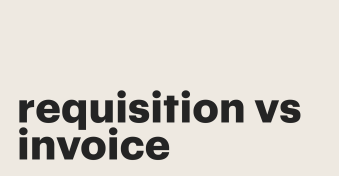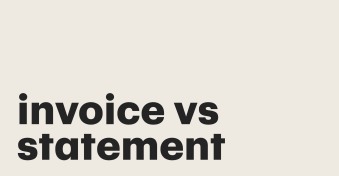If you’re trading internationally, you’ve probably heard of proforma invoices and commercial invoices. But which ones do you need to produce and when?
This article will explore proforma invoice vs commercial invoice to ensure that you’re always using the right document at the right time.
Key takeaways
- Proforma invoices are sent before a purchase has been made.
- Commercial invoices are sent after a purchase, and the order has been shipped.
- The main differences between proforma invoices and commercial invoices are timing, purpose, legal status, and tax/customs relevancy.
- Key elements of both invoices include a detailed description of the value and quantity of goods.
What is a proforma invoice?
A proforma invoice, by definition, is a preliminary bill or quote sent from a company to a potential buyer.
It contains an estimate of what the potential buyer will be charged for purchasing the proposed goods or services, alongside other key transactional information.
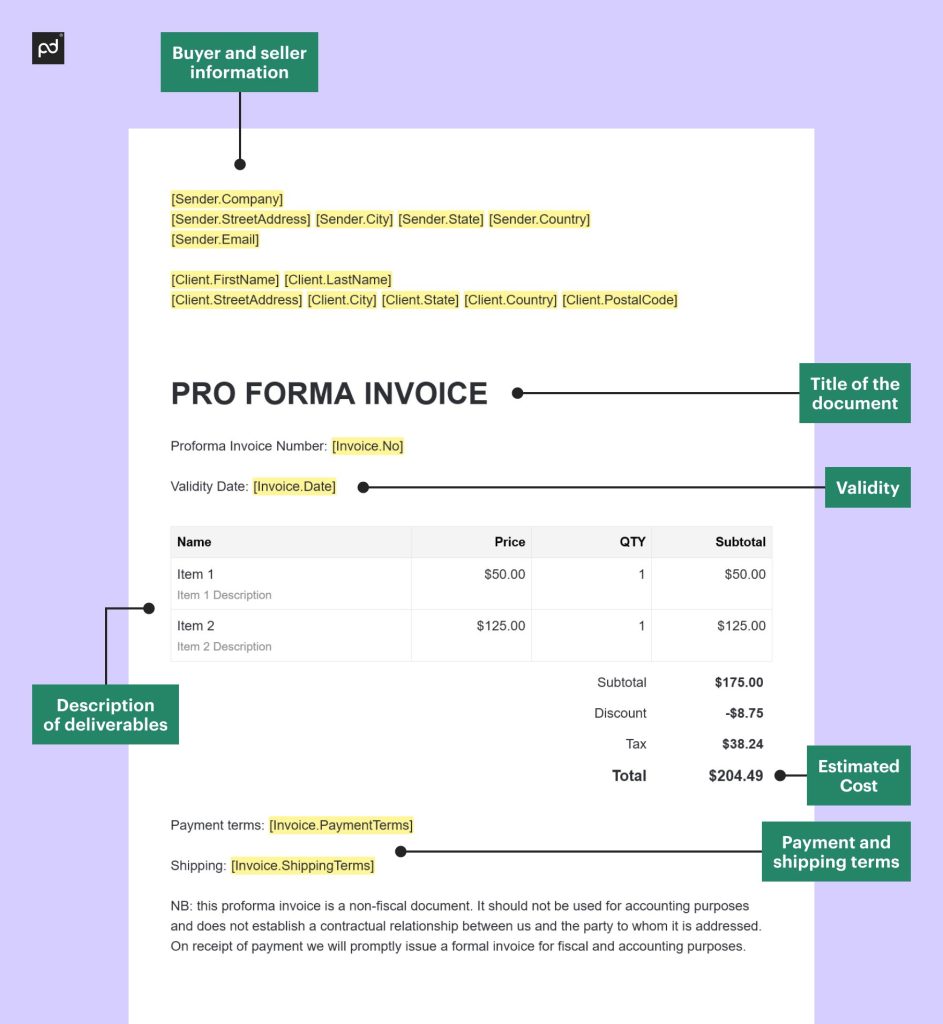
What is the purpose of a proforma invoice?
First and foremost, a proforma invoice presents prospective buyers with a detailed breakdown of the deliverables and charges they can expect in a potential sale. It’s essentially a “draft invoice” in that buyers get to see what the bill might look like should they go ahead with the purchase.
The benefits of doing this are significant. It provides transparency to the process, building trust and increasing customer confidence. It also aids negotiations, helping both parties reach a mutual agreement faster.
When is a proforma invoice used?
A proforma invoice is always sent before any goods or services have been provided to the client.
In most cases, the client has expressed a vested interest in the sale but hasn’t formally committed to the purchase.
You aren’t legally required to send proforma invoices, but they’re incredibly useful in some scenarios.
For example, you might use proforma invoices for:
International trading
As international trading requires additional costs, such as taxes and import fees, prospective buyers often request them to aid their accounting process and make cash flow projections.
Custom orders
A custom or personalized order doesn’t abide by the same pricing rules as set items or services. Proforma invoices break down the cost of custom orders, giving buyers full transparency into their purchase.
Business comparisons
If a buyer wants to compare costs across different businesses, proforma invoices act as quotes that can help customers decide.
What are the key elements of a proforma invoice?
They might not be legally binding, but professional proforma invoices still need to contain specific information to be of value.
The key elements of a proforma invoice include:
- The title of the document: This should always be “Proforma invoice” to avoid any confusion.
- Buyer and seller information: Make sure to include the name, address, and details of not just your company but the buyer too.
- Description of deliverables: Clearly list the goods and services that you’re offering the client, including the specifications, units, and any custom information.
- Estimated cost: Provide a detailed cost breakdown that communicates the individual cost of each good or service. Don’t forget to include additional costs like shipping fees or taxes.
- Payment and shipping terms: Specify the payment method, currency, shipping method, and estimated delivery date.
- Validity: Include an expiration date to let customers know how long they have to accept the offer.
Want to create your own proforma invoice?
You can use a handy proforma invoice template to ensure you include all the essential elements.
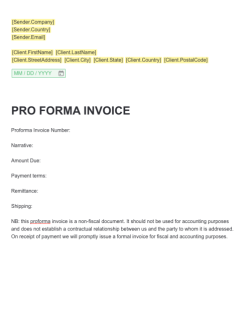
Proforma Invoice Template
Used 4995 times
Use this proforma invoice template as a sample to give your customers before providing a product or service.
Use this templateWhat is a commercial invoice?
A commercial invoice is a formal, legal document sent to the buyer once they’ve officially placed an order and the goods have been delivered.
It’s essentially the “final” or “official” invoice that requests payment from the buyer.
When used in global trading, a commercial invoice specifies the quantity and value of the deliverables being shipped internationally.
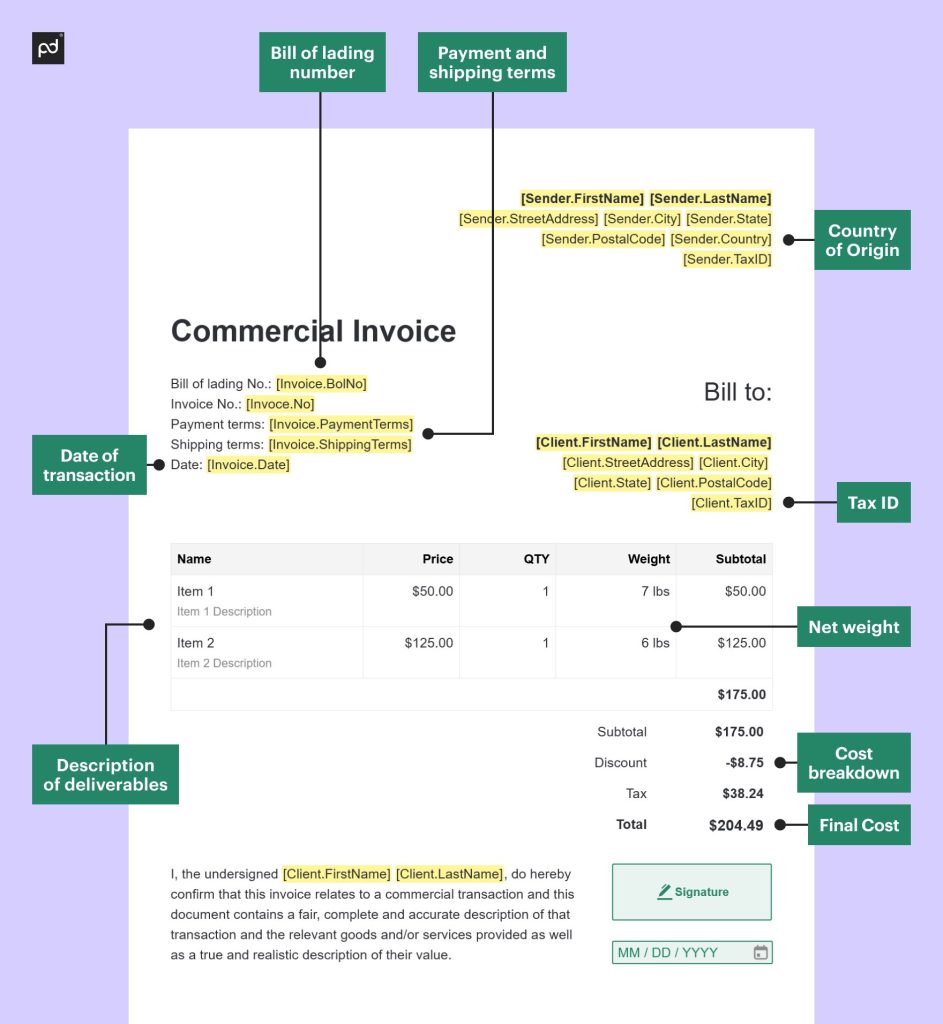
What is the purpose of a commercial invoice?
Commercial invoices act as the primary shipping document in international trading.
They’re used by customs to clear goods and calculate charges like duties and taxes.
Commercial invoices also serve as proof of contract between the buyer (importer) and the seller (exporter).
When is a commercial invoice used?
Commercial invoices are legally required in international trading.
So, if your business ships goods across the border — whether it be via land, ocean, or air freight — you’re bound by law to issue a commercial invoice to the buyer.
A commercial invoice may also request payment for goods or services already delivered or completed.
What are the key elements of a commercial invoice?
As commercial invoices are legally binding documents, it’s essential that they contain the relevant information.
Aside from the basic information that you also get in every type of invoice (such as buyer/seller information), the key elements of a commercial invoice include:
- An accurate description of deliverables
- A cost breakdown of the products that were shipped
- Country of origin
- Date of transaction
- Tax ID numbers
- Net weight of goods
- The bill of lading number
- Payment and shipping terms
- The final cost
Use a commercial invoice template to make sure that your invoice contains all the legally required information.

Commercial Invoice Template
Used 4979 times
Use this free sample of a commercial invoice template to process any trans-border shipments. You can use this along with our tax invoice template to process the different VAT or sales tax.
Use this templateProforma vs commercial invoice: what’s the difference?
The difference between commercial and proforma invoices lies in four main areas: timing, purpose, legal status, and tax/customs relevancy.
Let’s explore it in a little more depth using a comparisons table:
Commercial Invoice vs Proforma Invoice
| Proforma | Commercial Invoice | |
| Timing | Issued before a purchase has been made | Issued after a purchase has been made |
| Purpose | To provide potential buyers with an estimate or quote of the prospective transaction | Acts as the finalized proof of contract and is used by customs to clear goods and assess duties and taxes |
| Legal Status | Not legally binding, used for “good faith” purposes only | A legally binding document that is required by law for international trading |
| Tax and Customs | Used to assist buyers in their calculations for cash flow projections | Serves as primary tax documents and finalizes the calculations for duties and taxes |
So, commercial vs proforma invoice — they have several key differences that set them apart. But are there any similarities?
What are the similarities between a proforma invoice and a commercial invoice?
To fully understand the similarities, let’s first answer a fundamental question: what is an invoice?
An invoice is an itemized document that records a transaction between a buyer and a seller.
At their core, all invoices serve the same purpose — to declare to the buyer the total amount payable.
So, despite their differences, proforma invoices and commercial invoices do have similar key qualities. You’ve probably realized that they both:
- Declare the value of goods
- Include basic details like buyer and seller information
- Detail payment and shipping terms and conditions
- Provide an anticipated delivery date
- Include the seller’s signature (it’s not a legal requirement to sign an invoice, but it helps to build trust and resolve disputes)
Create, send, and manage invoices with PandaDoc’s document generation software
Proforma invoices, commercial invoices, sales invoices, and more — make invoicing effortless with PandaDoc.
Using PandaDoc’s document generation software, you can create, send, track, and securely eSign invoices from one platform, all in just a few clicks.
Access customizable templates, automated data entry, and a range of powerful software integrations that instill convenience and confidence into your invoicing process.
Interested?
Sign up for a demo to see for yourself what it can do.
Frequently asked questions
-
If you want to ship goods across international borders, then yes — you’re legally required to provide a commercial invoice. However, for local or domestic shipping, there’s no need to send invoices.
-
Proforma invoices can be used for customs declaration and can aid tax and duties calculations, but they’re not a necessity. Commercial invoices, on the other hand, are essential for customs clearance.
-
Proforma invoices and commercial invoices serve different purposes. From a legal standpoint, you need a commercial invoice if you’re shipping internationally. They’re also essential for tax and accounting purposes.
A proforma invoice is useful for building trust with international clients. However, you don’t strictly need one — it’s more of a nice-to-have.
Disclaimer
PandaDoc is not a law firm, or a substitute for an attorney or law firm. This page is not intended to and does not provide legal advice. Should you have legal questions on the validity of e-signatures or digital signatures and the enforceability thereof, please consult with an attorney or law firm. Use of PandaDoc services are governed by our Terms of Use and Privacy Policy.
